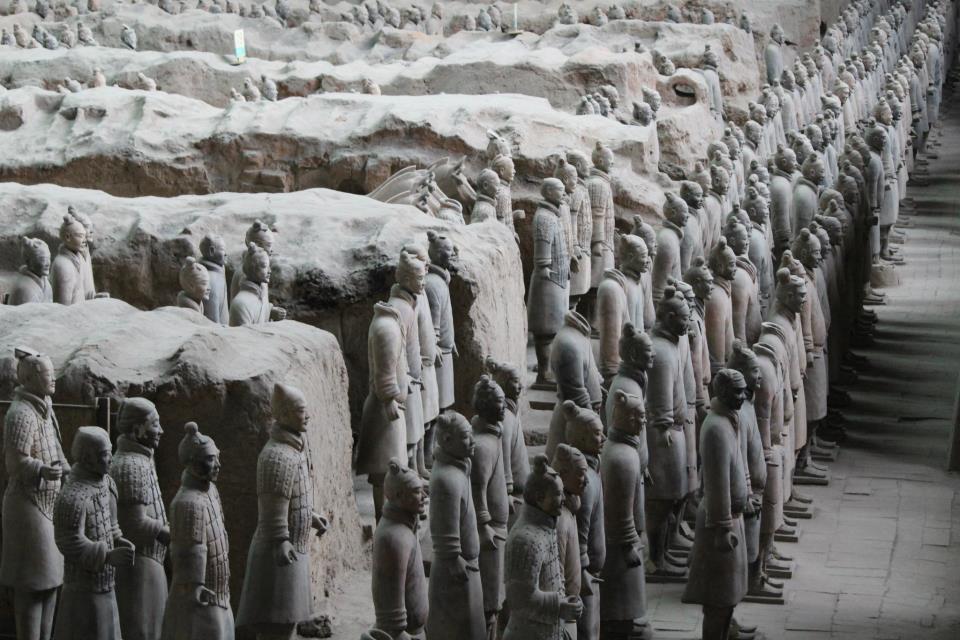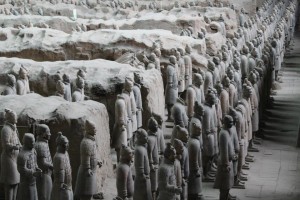” Our trip to Xi’an was the third class trip out of Hangzhou, second mandatory class trip, and is probably the most distant class trip outside of Hangzhou with a 2.5 hour flight. Xi’an was a strange and remarkable city, needless to say, vastly different from Hangzhou. Knowing that many foundations of thousands of years of political, and cultural history were born, here, in this very region seemed to make things all the more unusual and enigmatic besides the more practical differences. Certainly, much of the class already seemed to comprehend the sheer enormity of the impact of Qin and Tang dynasties on future generations of Emperors, bureaucrats, artisans, and so forth.
The first day fell like an anvil. It hit us hard. Most of us (including the narrator) were relatively unprepared until the morning of, thus we spent much of the late night packing. And of course, even after packing, there was always a certain specter of excitement, knowing just under 4.5 hours, we would board a plane to visit the very roots of bureaucracy. By about 4:30 am most of class was already awake and by 4:55pm most people were ready to board the bus—however the bus did not depart for some 10 minutes after 5am. Needless to say, the bus and plane ride over was deathly silent. Upon our arrival, the climate difference was most evident. Xi’an was dusty and rather dry and greatly contrasted Hangzhou’s humidity and vegetation. Perhaps party because of a relative absence of vegetation, the air seemed somewhat more polluted. The smoggy air nuanced many, including my roommate, and especially those whom were already suffering from illness, which has been felt across the international dormitories.
We finally checked into our hotel rooms around 11, 11:30am and ate lunch shortly afterward. By some by some miracle or hand of God, Professor Lin allotted us an unscheduled, but much needed nap between 1-2pm. After which, we visited the exterior of the Early Chinese dynasties history museum and the exterior of the White Goose Pagoda. The Chinese dynasties museum was surprisingly good. I thought it was interesting that by having the artifacts sorted by each dynasty, one could roughly compare and contrast what each dynasty emphasis. The early Zhou period had many ritual vessels and various bronze artifacts indicating that the Zhou government found at least some if not most of it’s legitimacy through religion and religious ceremonies.
We went and ate at a large mall like food court near the White Goose Pagoda. It was a peculiar mall/food court because of it’s notable ceiling featuring an enormous moving electronic image. It was like the ceiling had one screen saver of epic proportions that changed themes every 10 minutes. I apologize for not adequately describing this phenomenon. Needless to say, this rather gaudy technological demonstration dazzled everyone. By 8:15pm, everyone was ready to return to their appropriate hotel rooms.
The next day, we visited the most famous terracotta soldiers dating back to the end of the Qin Dynasty. Paxton, Nelson, and I wandered around the three different chambers. While the well-known, well documented chamber 1 was very impressive, it was very surprising to us how little they have managed to uncover, especially in the other chambers. We can only imagine the thousands more buried underground. We decided that it would be very interesting to return to Xi’an in three or four decades to see how much progress they have accomplished. Hopefully, with future technologies that will enable to preserve the soldiers better, the Chinese archeologists may have the ability to uncover the rest. I cannot help myself but laugh at the fact that Qin Shihuang’s terracotta army is, by far, the most disciplined army the world has ever seen—considering that they have had sentry duty in perfect formation for over two millennia.
After the terracotta army, we moved on to the local Hui mosque. It was a very small mosque—of course, hardly anything similar to the ones found in Jerusalem, Spain, North Africa or the Middle East. It was very natural looking with scattered pools of lily pads and fish and sporadic trees. It was a nice break to simply sit down and enjoy the nice weather. I felt a separation between inside the Mosque and the outside (which was an enormous market). Of course, after visiting the mosque we visited the Hui market, which was filled with various trinkets, food, make name-brand clothing items, and communist memorabilia. Everything was to be bartered for. Some were better than others at this, but I soon discovered that I was not one of them. We departed for dinner by 5pm. The next day was fairly uneventful. We had free time between 11am and 6:30pm. The vast majority of our group returned to the Hui market to get massages and to continue the exploring that was cut short from the day before. By 6:30pm, everyone was ready to return to Hangzhou, and thus we did promptly. Our three days covered only a small increment of the city. There was much that we neglected to spare time for. My speaking professor stated that, “you could easily spend an entire month trying to explore Xi’an. Three days is not enough.”
Nonetheless, it was a good trip and I hope that any future class trips are just as fruitful and educational as Xi’an.” -Matt


Leave a Reply